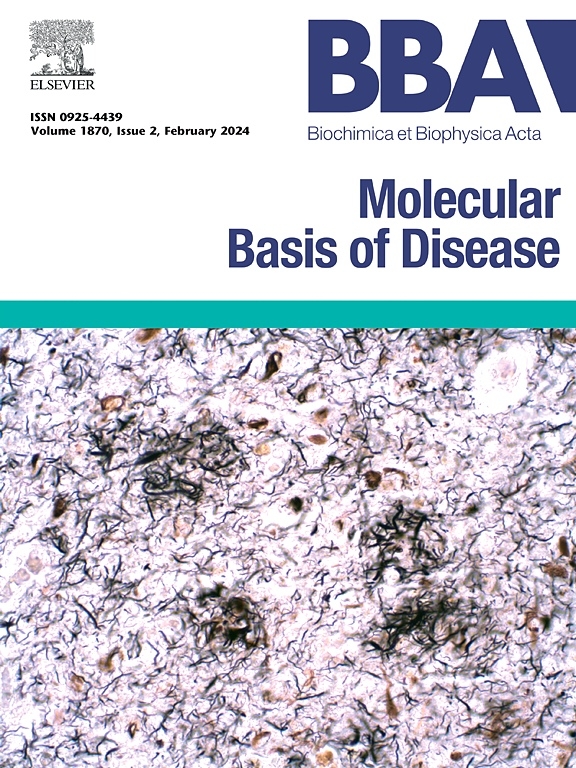Pinocembrin reduces pyroptosis to improve flap survival by modulating the TLR4/NF-κB/NLRP3 signaling pathway
IF 4.2
2区 生物学
Q2 BIOCHEMISTRY & MOLECULAR BIOLOGY
Biochimica et biophysica acta. Molecular basis of disease
Pub Date : 2025-02-08
DOI:10.1016/j.bbadis.2025.167710
引用次数: 0
Abstract
Background
Pinocembrin has been widely utilized in clinical settings as a topical treatment for detoxification, inflammation reduction, and healing dermal conditions such as cracked skin and burns.
Methods
In this study, pinocembrin was administered to hypoxia-reoxygenation model in human umbilical vein endothelial cells and 36 rats for 7 days using the McFarlane flap model. Neovascularization was then assessed using Doppler and lead oxide gelatin angiography. Neutrophil infiltration and mean microvessel density were assessed through hematoxylin and eosin staining. Immunofluorescence was employed to assess neovascularization and inflammation by detecting vascular endothelial growth factor, interleukin-1β, interleukin-6, and tumor necrosis factor-α. Pyroptosis was evaluated using western blot analysis.
Results
Compared with the control group, the experimental groups exhibited a significant increase in flap survival area with the promotion of neovascularization, mitigation of oxidative stress, and suppression of pyroptosis and inflammation.
Conclusion
Pinocembrin enhanced flap survival, promoted neovascularization, mitigated oxidative stress, and suppressed pyroptosis and inflammation by downregulating the TLR4/NF-κB/NLRP3 signaling pathway.

匹诺曹通过调节TLR4/NF-κB/NLRP3信号通路减少焦亡,提高皮瓣存活
匹诺曹已广泛应用于临床环境作为局部治疗解毒,消炎,愈合皮肤状况,如皮肤开裂和烧伤。方法采用McFarlane皮瓣建立人脐静脉内皮细胞缺氧-再氧合模型,36只大鼠给予皮诺松注射液7 d。然后用多普勒和氧化铅明胶血管造影评估新生血管。苏木精染色、伊红染色测定中性粒细胞浸润及平均微血管密度。采用免疫荧光法检测血管内皮生长因子、白细胞介素-1β、白细胞介素-6和肿瘤坏死因子-α,评估新生血管和炎症。采用western blot法检测焦亡情况。结果与对照组相比,实验组皮瓣存活面积明显增加,促进新生血管形成,减轻氧化应激,抑制焦亡和炎症。结论匹诺诺皮通过下调TLR4/NF-κB/NLRP3信号通路,提高皮瓣存活,促进新生血管形成,减轻氧化应激,抑制焦亡和炎症反应。
本文章由计算机程序翻译,如有差异,请以英文原文为准。
求助全文
约1分钟内获得全文
求助全文
来源期刊
CiteScore
12.30
自引率
0.00%
发文量
218
审稿时长
32 days
期刊介绍:
BBA Molecular Basis of Disease addresses the biochemistry and molecular genetics of disease processes and models of human disease. This journal covers aspects of aging, cancer, metabolic-, neurological-, and immunological-based disease. Manuscripts focused on using animal models to elucidate biochemical and mechanistic insight in each of these conditions, are particularly encouraged. Manuscripts should emphasize the underlying mechanisms of disease pathways and provide novel contributions to the understanding and/or treatment of these disorders. Highly descriptive and method development submissions may be declined without full review. The submission of uninvited reviews to BBA - Molecular Basis of Disease is strongly discouraged, and any such uninvited review should be accompanied by a coverletter outlining the compelling reasons why the review should be considered.

 求助内容:
求助内容: 应助结果提醒方式:
应助结果提醒方式:


